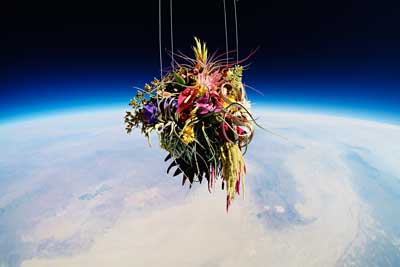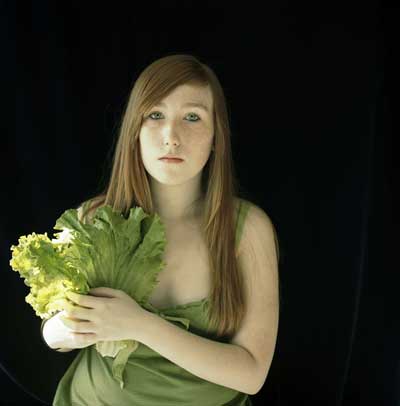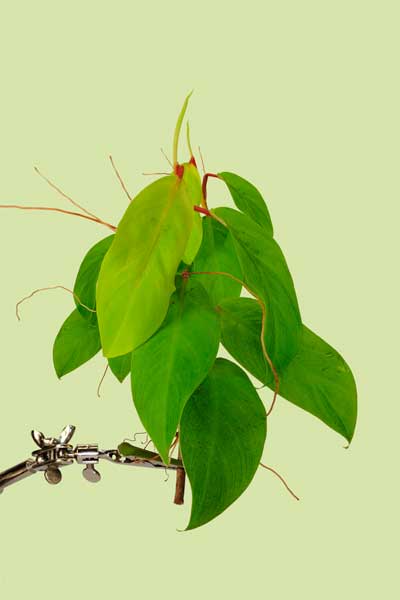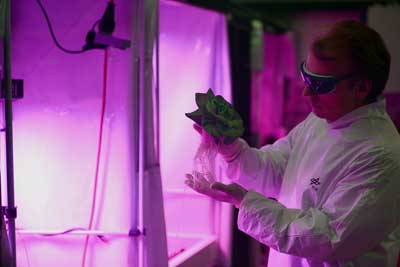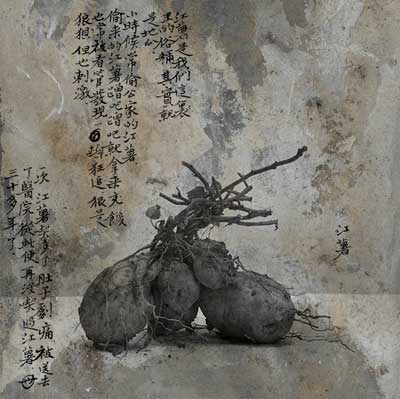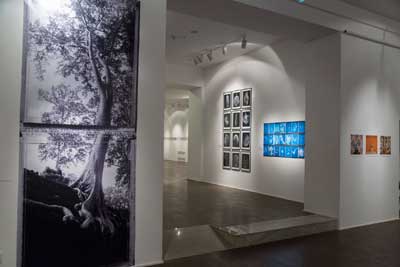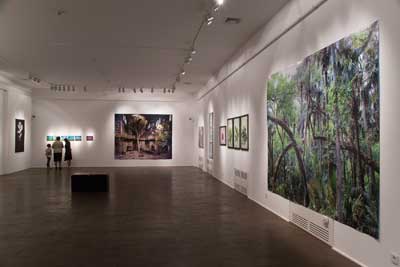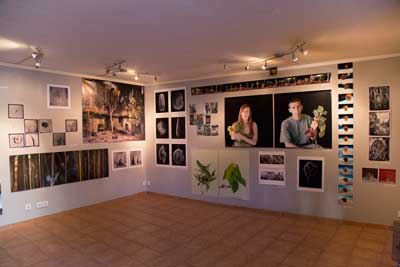 |
|
|
Rückblick Aktuelle Ausstellung Kontakt Impressum |
|
|
30 Jahre Galerie Lichtblick Space Veggies & Earth Plants #123.9. - 23.10.2016
Andrej Barov, München, Germany Die Ausstellung findet im Rahmen der Internationalen Photoszene Köln 2016 statt.
Space Veggies and Earth Plants Photographs of plants. Plants for their own sake. As an aesthetic or biological alternative to everyday life, society and civilization up to now. Plants as intelligent and resistant living organisms on the evolutionary path from earth to outer space. Art and amateur photography is cognisant of the motifs of man and beast, tree and flower in their paradisical simplicity. Journalistic documentation records the destruction of rain forests and biodiversity. Advertising revels in the values of recreation and consumption. Nature becomes the background setting, the fruit bowl and vegetable platter. Even in still life it is kept marginal, something between décor, color, fragrance, medicinal herb, drug, nourishment, prey and fuel. The future-trending research and documentation of the floral and the vegetal can be found at the interface between science, art and technology, the global and the interplanetary between ecology, climate change, terraforming and in an exodus to other celestial bodies. The terrestrial evolution seems to have gone through a gradual ascent, from algae and moss to the vascular plants with roots, sprouts and leaves, trees, shrubs, herbs to flowers. In the zero gravity of space, growth accelerates and reaches new dimensions.
The photographs on show bridge the gap between civilization, evolution and nature. Procedures that are artistic and everyday, structural and documentary, investigative and symbol-depicting serve the photographic comprehension and portrayal of living things: between potential use, genetic manipulation and pure enjoyment. Biological phenomena today are generated via natural growth, virtual construction and purposeful breeding. The pictures of nature, the subtext of the plants, change from a traditional life source to an object of economic exploitation and scarcity, to a test field of industrial standardization and to a gateway to unforeseen transformations. The aesthetic reflection of our home planet’s uniqueness is linked to our wonder at the fascinating ingenuity of evolution, here on earth and in outer space. Dr. Peter V. Brinkemper Space-Veggies and Earth-Plants Fotografien von Pflanzen. Pflanzen um ihrer selbst willen. Als ästhetischer oder biologischer Gegenentwurf zum bisherigen Alltag, zur Gesellschaft und Zivilisation. Pflanzen als intelligente und resistente Lebewesen auf dem evolutionären Pfad von der Erde ins All. Kunst- und Amateurfotografie kennen die Motive von Mensch und Tier, Baum und Blume in paradiesischer Einfalt. Die journalistische Dokumentation berichtet von Zerstörungen des Regenwaldes und der Artendiversität. Werbung schwelgt in Erholungs- und Konsumwerten. Natur wird zur Hintergrundkulisse, Fruchtmenü und Gemüseplatte. Selbst im Stillleben wird sie zur Marginalie, zwischen Dekor, Farbe, Duft, Heilkraut, Droge, Nahrungsmittel, Opfer und Brennstoff. Die zukunftsweisende Erforschung und Dokumentation des Floralen und Vegetabilischen findet an einer Schnittstelle statt, zwischen Science, Art und Technologie, global und interplanetar zwischen Ökologie, Klimawandel, Terraforming und im Exodus zu anderen Himmelkörpern. Die terrestrische Evolution scheint einen langsamen Aufstieg genommen zu haben, von Algen und Moosen zu den Gefäßpflanzen mit Wurzeln, Spross und Blättern, Bäumen, Sträuchern, Kräutern und Blütenträgern. In der Schwerelosigkeit des Alls wird Wachstum beschleunigt, Proportionen erlangen neue Dimensionen.
Die Fotografen in dieser Ausstellung schlagen Schneisen und Brücken zwischen Zivilisation, Evolution und Natur. Künstlerische und alltägliche, strukturelle und dokumentarische, investigative und symbolisch-darstellende Verfahren dienen der fotografischen Erfassung und Darstellung des Lebendigen: zwischen möglicher Nutzung, genetischer Manipulation und reinem Wohlgefallen. Biologische Erscheinungen werden heute erzeugt durch natürliches Wachstum, virtuelle Konstruktion und gezielte Züchtung. Das Bild der Natur, die Botschaft der Pflanzen verändert sich vom traditionellen Lebensquell zum Objekt ökonomischer Ausbeutung und Verknappung, zum Testfeld industrieller Standardisierung und zur Pforte ungeahnter Transformationen. Die ästhetische Reflexion auf die Einmaligkeit unseres Heimatplaneten Erde verbindet sich mit dem Staunen über den faszinierenden Einfallsreichtum der Evolution, hier und im All. Dr. Peter V. Brinkemper
Elaine Ling, Toronto, Kanada. Angkor Stones 1999. Gigant Trees with roots and radices, expansive networks of roots, a tropical rizosphere, with ground roots and arial roots, a drama of fertility and death, compact and hollowed out host trees. The roots are intruding into the Angkor Wat temple complex in Cambodia. The Khmer Empire mausoleum of the kings gradually transformed into buddhists temple buildings. Elaine Ling, born Hong Kong, Canadian doctor and photographer, has explored in black and white pictures remote places, abandoned settlements, mystic monuments and strange geological formations, the erosion and transformation of inside to outside. Her topic was the real dimension of time, the difference between short human chronology and the infinite mythical time of nature. Lydia Panas, Kutztown, Pennsylvania, USA. Falling from Grace. 2009/10. Ambivalent portraits of single humans of different age, offering something to eat tot he viewer: fruits, plants, veggies, sea food etc. The gesture of offering and the object of donation is connected with a complex poker face situation of the model, between reticence and openness, sincerety and irony – a situation between trust and temptation. The portraits remind of old Dutch painting, but have a modern twist. Robert Zhao Renhui, born 1983. Singapore. Pretenders. 2008/9. Pretenders are the more or less extroverted animal agents of mimicry, of natural lie and deceit. Pretention is the other side of camouflage, both the natural performance of the visible and the invisible, the ostentation and the disguise between preys and predators. Insects use leaves and plants as a cover and may imitate this environment, either to defense themselves not to become a prey, or to dissimulate themselves as predators. Even plants, male and female partners, try to deceit others, to secure exclusive fertilization and pollination. Mimicry can be a step of evolution. The moment of pretention may be turned into revelation and unmasking. Robert Zhao Renhui is a sceptical and agnostic photographer who reflects the trials and errors of cognition and of evolution. He touches a further dimension: animals and plants affected by aesthetic and genetic modification, ecological conservation, evolution and pollution. And the problem of fake nutrition and fake house pets. Will evolution strike back?
Michael Najjar, born in 1966. Berlin, Germany. Space Garden, in the series Outer Space, since 2011. The artist combines photography, video and computer graphics. He deals with new austronautics leaving definetly earth, to overcome apocalyptic boundaries and to find new habitats and homes elsewhere. He encircles the vision of a biosphere which dissolves from Earth, and is traveling in space or settling on a neighbour planets. He intends the fusion of present observations and visions, digital numbers and visual images, to give us the fata morgana of the technological models and data landscapes from economics, bionics, urbanistics and spacetravel in order to redesign utopian dreams of the 60s. This media artist applies the contrast between visual realism and dynamic hyperreality of an exploding data universe. The conventional nature appears somehow denatured, even postromantic between utopia and dystopia by cool and distant reproduction. Wei Bi, born 1969. Beijing, China. Mengxi II. 2010-13. „Wei Bi’s birthplace, Meng Xi, is a village north of Hu’nan province which used to be an important pit stop for salt traders heading to the southwest. For him, Meng Xi’s significance lies far beyond a physical dwelling place – it is a womb and sanctuary containing the essence of his life. Through his photographic practice, he recaptures colourful personalities and unforgettable experiences from childhood. Accompanying these images are handwritten accounts of those memories. Like a visual diary, this series represents a time capsule of a generation once innocent and simple. Catharsis eventually surfaces – a soothing of the homesickness of his rural-urban migration.“ Joachim Froese, born 1963. Australia, Germany. Brisbane and Berlin. Born in Montreal/Canada, grew up in Germany and migrated to Australia in 1991. Highly constructed still life photography, which investigates cross-overs with art history, personal memory, portraits and nature photography. Here: Germlings 2015. Wolfgang Zurborn, born 1956. Cologne, Germany. dressur real, 2001. Urbanity und nature as one world of photographic signs. Melissa Moore, born 1978. London, GB. Lands Ends, 2013. Hornby Island, Canada. Exploring the ecological territory through a sequence of still lifes, landscapes and performative interventions. The crossover of exploration und staging, poetry and social research: the post-romantic imagination of a dystopian island with trees, debris of storm and natural shelters, being the origin of vernacular architecture. Melissa Moore begins to live in the wood between mere camouflage and growing sustainability. In the spirit of Thoreau, Emerson and Whitman. Stefen Chow, born 1980, Malaysia. Bejing, China. The Poverty Line. Since 2010. The long term project explores a simple question: what does poverty mean in different countries? Stefen Chow and Hui-Yi Lin started their collaboration in China and have since expanded to 24 countries across 6 continents. „The Poverty Line uses the universal lens of food to examine the choices you would face if you lived at the poverty line.“ Statistics of per-person, per-day expenditure based on the country’s national poverty line, are expressed by visual representation of everyday food items that would be accessible within that country for that amount of money.
Daniel & Geo Fuchs, born 1966 and 1968, Germany. Forest 2009/10 (Florida). Conceptual photographer-team, working on social and historical topics and examining the media border between documentary realism, imagination and digital postproduction. They adopt various possibilities of shaping, modelling and compositing motifs and pictures, by mixing elements of reality and fiction. Andrej Barov, born 1959, Russia, Munich, Germany. Wüstlinge. C-Prints 2002. Digital constructed and painted plants embody virtues and vices in nature. "Libertines" and “rakes” in the desert is the ambiguous title for strange plants, flowers and tress, alone in the wild (“Wüstlinge”). They growth from the monotonous sandy soil and sprout unknown leaves, flowers and spines out of their trunk and stems. Cactus, dandelion, orchid, more or less leafy trees refer to seasons and climate and adopt via the theatre of shapes, patterns and colors different graphic characters: the digital mimicry of inconspicuous, boastful, bizarre, elegant, well-fortified and peaceful beings who take the viewer to an imaginary journey into the virtual nature - in search of the wraps of wild blue flower. Laurie Lambrecht, born in 1955. New York, USA. The photographer dissolves a familiar garden plant in close-ups to a deep thicket: the "Bamboo Street" is tansformed into a "Jungle Road" (so the title of the series). Trunks, strips and air roots appear in front of darker or brighter background. Foreground shades and drapery effects mingle with the foliage in different color values in lines or dots. She procuced this series in her Rauschenberg Residency, 2014. Laurie Lambrecht exposes with "China 2009" nature in Far Eastern autumn. Her photographic study of a bough evolves the calligraphic forms of a bald tree. Vadim Gushchin, born 1963.Moscow, Russia. Fruits of the earth. 1998. The series provides a different staging compared to his former suprematist-like artworks. Fruits next to staged objects and the irony of directly undertaped German titles function as playful metaphorical accessories against simple identity: an artificial chicken and the egg, real, the pear, overripe, and a toy-mouse, bread and wine, with a wooden wine-cup, the apple, a wilted rose and the radish, a multiplicity, viewed from below. Between the units, there are broad links of shifting forms, materials, meanings and symbols, translations of art into life. Post-conceptual photography plays immanently with modern strategies and transform them into an open everyday experience. Azuma Makoto, born 1976, Japan, France, USA. Exobiotanica – Botanical Space Flight 2014. He is a flower sculpturist, producing massiv objects of solid expression with natural materials (mega bouquets, ice flowers) and public medial botanical installations. His art has commercial aspects but is also linked with space and environmental aspects. In July 2014 he sent with two ballons from Black Rock Desert in Nevada into the stratosphere, on a mission, entitled ‘Exobiotanica’, a 50 year old pine bonsai, suspended in a carbon-fiber cube-frame, and an arrangement of orchids, hydrangeas, lilies and irises, among other plants. Both helium ballons were specially equipped with high-resolution-cameras to document in 12.000 pics the steps of the plants into the unknown, drifting away from bright earth to dark sky nearly beyond atmosphere, entering a short time existence, unsheltered, without soil, air and gravity. |
|
Andrej Barov, München, Germany Space Veggies & Earth Plants #1 23.09. - 05.11.2016 Eröffnung: Zur Eröffnung spricht Peter V. Brinkemper Finnisage: Weitere Ausstellungen: Birte Kaufmann The Travellers Dougie Wallace Simon Norfolk Kai L?ffelbein Thekla Ehlin Kolga Tbilisi Phto Meeting 2016 Anais Lopez Betsy Schneider Dona Schwartz Elaine Ling He Ladies Only #3 Imran Ahmed Arko Datto Shruti Desai Shubham Dharmsktu Ma The India Vision Quest Dieter Röseler Deutschland 5 Uhr 30 Wolfgang Zurborn Catch Brian Griffin Chris Suspect Richard Bram Oyvind Hjelmen Kolga Tbilisi Photo Meeting 2015 Linda Troeller Mariette Pathy Allen Mary Ann Lynch Regina Ladies Only #2 Aline Smithson Beatrix Reinhardt Joanna Black Karen Glase Ladies Only #1 Harvey Benge Steven Benson Chili Stefen Chow Nathalie Da Chine Today |
| © 2026 Galerie Lichtblick, Gesellschaft für fotografische Kunst e.V. Köln | Impressum |
